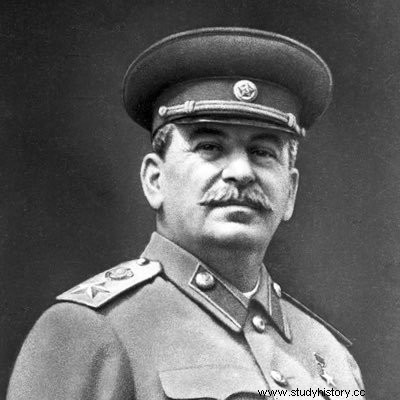 Summary:Joseph Stalin (1879-1953) was a politician and Soviet leader who dominated the political life of the USSR from 1924, occupying power until his death in 1953. By his political and military weight, he made USSR the second world power and its action had a determining influence on the territorial expansion of the communist model, in particular in Eastern Europe. "Iron Man fascinates today as much as yesterday it inspired fear, contempt...and idolatry. An essential figure in contemporary history, the errors and excesses of the "red tyrant" largely contributed to the subsequent discredit of the communist model.
Summary:Joseph Stalin (1879-1953) was a politician and Soviet leader who dominated the political life of the USSR from 1924, occupying power until his death in 1953. By his political and military weight, he made USSR the second world power and its action had a determining influence on the territorial expansion of the communist model, in particular in Eastern Europe. "Iron Man fascinates today as much as yesterday it inspired fear, contempt...and idolatry. An essential figure in contemporary history, the errors and excesses of the "red tyrant" largely contributed to the subsequent discredit of the communist model.
Joseph Stalin, from seminarian to revolutionary
Joseph Vissarionovitch Dzhugashvili was born on December 21, 1878 in Gori, Georgia. . However, a controversy took shape around the date of birth of Joseph Stalin when a birth certificate was discovered indicating the date of December 18, 1878. Originally from Ossetia and of Orthodox religion, the parents of the young Joseph were former serfs with benefited from the abolition of serfdom in 1861. While his father sank into alcoholism, Stalin's mother, Ekaterina Gavrilovna Gueladze, decided alone on her child's future and strongly encouraged him to become a priest.
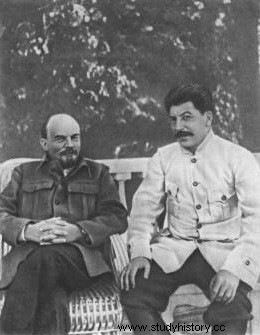 He entered the seminary of Tiflis in 1894. But he was expelled five years later for absenteeism, the young Georgian indeed enjoying frequenting Marxist militants and socialists . He draws from this adolescence a fervent atheist feeling. Political baptism, Stalin's enrollment in 1898 in a local branch of the Social-Democratic Labor Party of Russia earned him a first political arrest four years later, in 1902 . Sentenced to exile in Siberia for three years, he managed to escape in 1904.
He entered the seminary of Tiflis in 1894. But he was expelled five years later for absenteeism, the young Georgian indeed enjoying frequenting Marxist militants and socialists . He draws from this adolescence a fervent atheist feeling. Political baptism, Stalin's enrollment in 1898 in a local branch of the Social-Democratic Labor Party of Russia earned him a first political arrest four years later, in 1902 . Sentenced to exile in Siberia for three years, he managed to escape in 1904.
Then organizing the Baku strike during the 1905 revolution, the young Stalin gradually acquired political experience as a revolutionary Marxist . The same year, he met Lenin for the first time and became a fervent supporter. It was finally in 1912, during the 6th conference of the Social Democratic Workers' Party of Russia, that Stalin entered the Bolshevik Central Committee.
Stalin's political rise
Comrade Stalin gradually builds his network within the Bolshevik Party on the eve of the October Revolution e. He was elected to the party's Central Committee in April 1917, but since March has also been the editorial secretary of the propaganda newspaper "La Pravda ". From its creation in March 1919, he joined the Politburo , the main decision-making body in the Soviet institutions. Stalin actively participated in the civil war, inspecting the fronts and organizing the defense of Tsaritsyn in 1918.
Apogee of his rise within the Communist Party, Stalin was finally elected General Secretary at the XI Party Congress in Moscow on April 3, 1922. In 1922, Lenin, greatly weakened by a attack, concerned himself with ensuring his succession. Worried about the weight taken by the bureaucracy in the whole of the Soviet system, and the power concentrated in the hands of Stalin, secretary of the party, he wrote on December 24, 1922 a long letter to the Central Committee. In it he argued that "Stalin is too brutal" and proposed to "displace Stalin" and "appoint someone else who would have in all things this advantage over Comrade Stalin of being more tolerant, more loyal, more polite , more attentive to comrades and would be in a less temperamental mood”. The leading authorities of the party, anxious not to favor the rise of Trotsky, chose to ignore this "testament" after the death of Lenin.
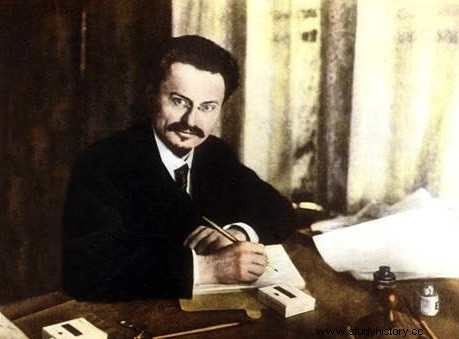 As soon as Lenin disappeared, a bitter struggle for power began within the Communist leadership. The most prestigious Bolshevik leader was now Trotsky, organizer of the October Revolution and the Red Army, but Stalin, general secretary of the party since 1922, had already concentrated immense power in his hands. Somewhat in the background, but also full of ambition, was Zinoviev, who, as president of the Comintern, believed himself to be the leader of the world revolution.
As soon as Lenin disappeared, a bitter struggle for power began within the Communist leadership. The most prestigious Bolshevik leader was now Trotsky, organizer of the October Revolution and the Red Army, but Stalin, general secretary of the party since 1922, had already concentrated immense power in his hands. Somewhat in the background, but also full of ambition, was Zinoviev, who, as president of the Comintern, believed himself to be the leader of the world revolution.
Stalin's rise was all the more remarkable because until 1941 he did not hold any official position in the hierarchy of the Soviet state. But the situation in the U.S.S.R. was such, from the moment of Lenin's death, that the general secretary of the party was in fact the master of the regime. It was by controlling the party apparatus, by placing men of his own at all levels, that Stalin, while contenting himself at first with an apparently effaced role, ensured supreme power in a few years.
No more than Trotsky, Zinoviev or Kamenev, who at first marched with the future dictator and formed with him the anti-Trotskyist "troika", realized in time this patient undermining. The controversy between Trotsky and the "troika" revolved mainly around the Trotskyist doctrine of permanent revolution. Trotsky was nostalgic for a world revolution and could not bring himself to accept the sacrifices involved in building socialism in one country, which Stalin was to champion.
Joseph Stalin in power
After having ousted all his political opponents, including Trotsky who was assassinated in 1940 in Mexico City, in 1929 became the undisputed master of power in the Soviet Union. He put an end to the new economic policy and the premises for the liberation of the country put in place by Lenin. Until 1933, he imposed the forced collectivization of the land, at the expense of the old system of peasant kulaks. The episode of the Ukrainian famine of the winter of 1933-34 which caused nearly 25 million deaths and the creation of the Gulag archipelago in 1930 are all manifestations of the nature of the Stalinist regime.
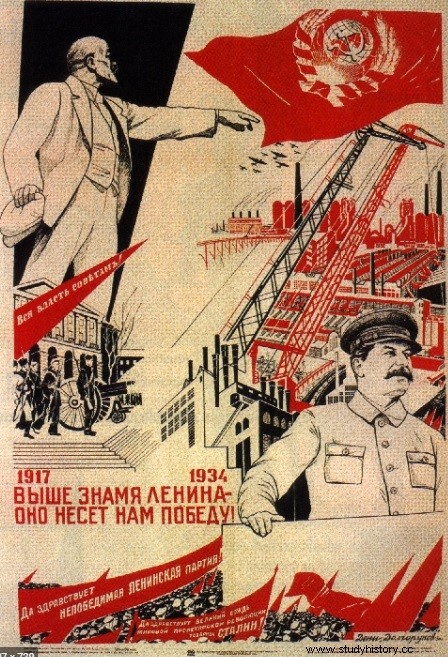 Economically, Joseph Stalin oversees through Gosplan created in 1928 the realization of five-year plans aimed at industrializing the Soviet Union at a forced march. In 1935, he created the myth of the worker Stakhanov, the cult of personality adding to the regime's usual propaganda. Domestically, Stalin decides to purge the party and the army elements that could potentially compete with his power. The “Moscow Trials » of 1936-38 saw the execution of many political figures (Zinoviev, Kamenev, Bukharin) but also of three of the five marshals of the Red Army.
Economically, Joseph Stalin oversees through Gosplan created in 1928 the realization of five-year plans aimed at industrializing the Soviet Union at a forced march. In 1935, he created the myth of the worker Stakhanov, the cult of personality adding to the regime's usual propaganda. Domestically, Stalin decides to purge the party and the army elements that could potentially compete with his power. The “Moscow Trials » of 1936-38 saw the execution of many political figures (Zinoviev, Kamenev, Bukharin) but also of three of the five marshals of the Red Army.
Well aware of the weaknesses of his army, Stalin also decided in the mid-1930s to carry out a more open diplomacy towards the Western powers. This is how the Soviet Union got closer to the United States (first country to recognize the Soviet Union in 1933), France (mutual assistance pact of 1935 ) but especially Germany (German-Soviet pact of 1939 ).
The "little father of peoples" and the Great Patriotic War
These events are the prelude to the outbreak of the "Great Patriotic War as theorized by Stalin in a July 1941 speech following the German invasion of the country. At first, Stalin was completely taken by surprise by the German attack of June 1941. This was foreseeable but came only two years after the non-aggression pact of 1939.
On the military level, the situation is catastrophic, the German army making a meteoric progression, seizing vast territories and taking very many prisoners. Stalin, Very dejected, Stalin completely disappears from the political scene for a long week, to the dismay of those around him. Having regained his lucidity, he addresses the population on the radio in a speech with very patriotic accents and calls for resistance against the invader.
 Stalin then personally took part in the conduct of certain military operations such as the counter-offensive in front of Moscow in the winter of 1941-42. Despite the massive purges of the 1930s, he could rely on a new generation of officers who were totally dedicated and determined to win the war. After the iconic Battle of Stalingrad , the course of the war was reversed, until the final victory of May 1945 .
Stalin then personally took part in the conduct of certain military operations such as the counter-offensive in front of Moscow in the winter of 1941-42. Despite the massive purges of the 1930s, he could rely on a new generation of officers who were totally dedicated and determined to win the war. After the iconic Battle of Stalingrad , the course of the war was reversed, until the final victory of May 1945 .
Joseph Stalin profited immensely from the Soviet victory in 1945. It is then the apogee of a Stalinist regime which is admired and feared as the winner of Nazism. The cult of personality is propagated to the extreme, and the entire Soviet sphere of influence is covered with statues and giant portraits to the glory of the “little father of the peoples ”.
The end of Stalin's reign
The Second World War enabled Stalin to endow the Revolution with an empire. He set up a protective glacis of puppet states in Eastern Europe aimed at protecting the USSR from a new foreign invasion. In all the countries of the sphere of Soviet occupation, communist governments are gradually being put in place, and must unreservedly support the line defined in Moscow.
The bipolarization of international relations is particularly evident during the blockade of Berlin west ordered by Stalin in June 1948 . However, this must give way after the Americans set up an airlift to supply the city. Stalin then proposes that Germany be reunited, disarmed and remain neutral in an attempt to ease the tensions arising from the occupation of the country. Having been refused by Westerners, he encouraged the creation of the Democratic Republic of Germany as well as its own currency in October 1949.
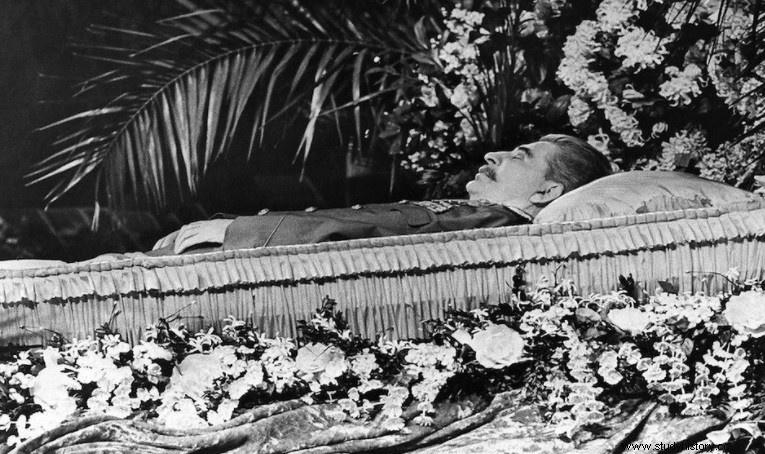 At the twilight of his life but still at the height of his power, Stalin again provoked political purges with the 1952 trials and the white coat plot at the beginning of 1953. This new phase of radicalization of the regime after the war (to which is added the resumption of pogroms) ended however with the death of Stalin, March 5, 1953 .
At the twilight of his life but still at the height of his power, Stalin again provoked political purges with the 1952 trials and the white coat plot at the beginning of 1953. This new phase of radicalization of the regime after the war (to which is added the resumption of pogroms) ended however with the death of Stalin, March 5, 1953 .
It marks the end of one of the bloodiest totalitarian regimes in contemporary history. From 1956, his successor Nikita Khrushchev denounced the crimes committed under Stalin's regime and undertook a vast campaign of "de-Stalinization". The body of the red dictator will be removed from Lenin's Mausoleum in 1961.
Bibliography
- Stalin:The Court of the Red Tsar by Simon Sebag Montefiore. 2005.
- Stalin by Jean-Jacques Marie. Biography, Fayard, 2003.
- Stalin, by Oleg Khlevniuk. Folio History, 2019.
